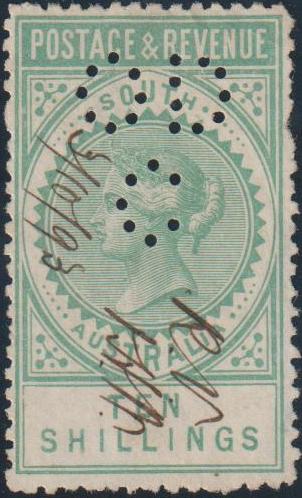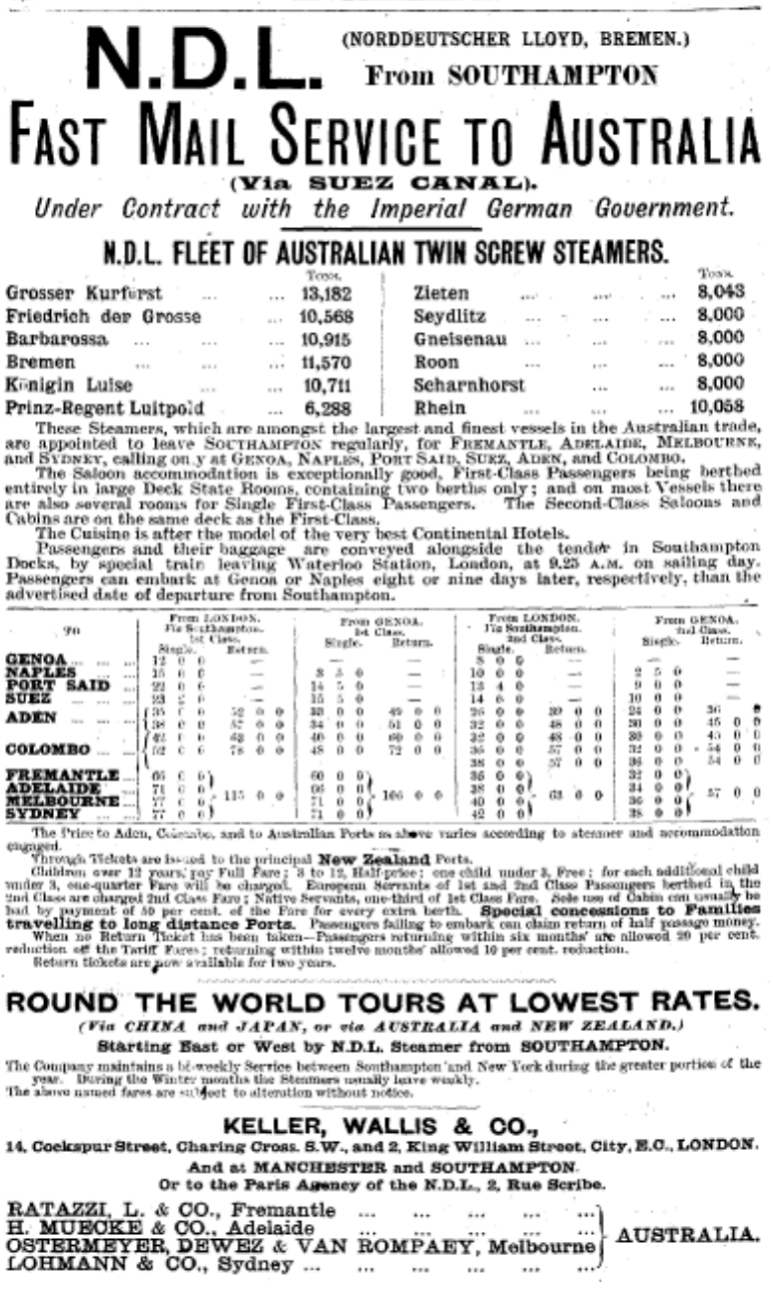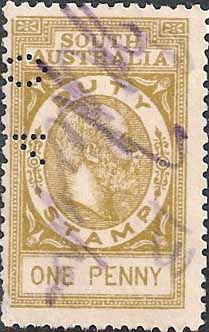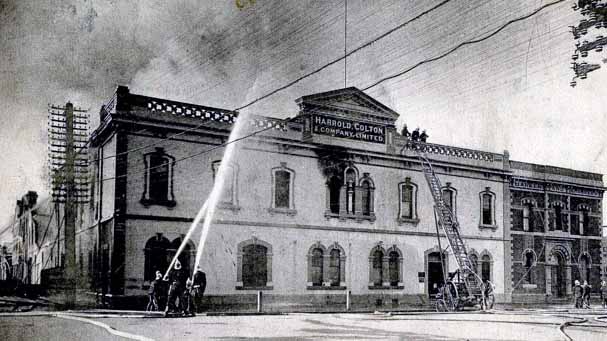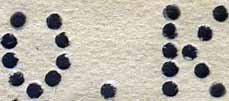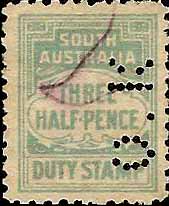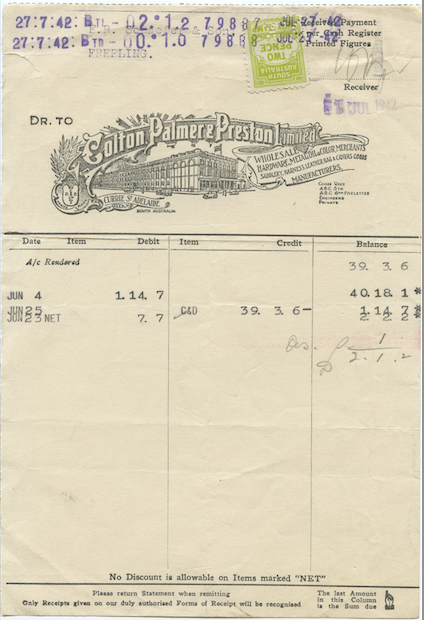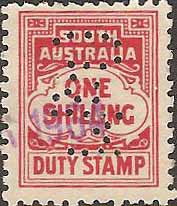|
Private Revenue Perfins of South Australia An Elsmore Coath production The authors would welcome your comments additions or input into this work O
-------------------------------------------------------- OD/C.a
User: Ostermeyer, Dewez & Co Wool Brokers Address: Currie St, Adelaide, SA. Revenue Use: 1893 Postage & Revenue 10/-. Rarity Scale: 1893 Postage & Revenue 10/- R5. Background: Initially the company traded as Ostermeyer, Dewez and Co (some source Ltd) from at least as early as 1884. They had offices in Currie St, Adelaide, 17 Macquarie Place, Sydney, Melbourne, and London. At this stage they seemed to have been involved in the importation of Iron and fencing products.The activities of the
company in Adelaide and Sydney are supported by
the use of perforating devices in the format of
OD/C, at these locations. Adelaide (1895) and
Sydney (1894-1904) are found on postage stamps.
The London Gazette
reports in August 1896 that the company of
Ostermeyer, Dewez and Co was wound up effective
March 1896 in a matter signed by the owners who
were Gustav Ostermeyer, Toussaint Dewez, Alfred
Van Rompaey and W Leslie Whyte.
From this point the
company is known as Ostermeyer, Dewez and Van
Rompaey & Co. Furthermore, the company seems
to change its focus from importing to exporting
and from Iron products to wool. In 1899 the Sydney
office moved to 52-54 Phillips St, Sydney, NSW.
The format of the
companies perforating devices support the change
in company name as they become OD/V and come into
service in Melbourne in 1899 and Sydney in 1905.
Notably the Sydney OD/C device is phased out at
the time of the arrival of the Sydney OD/V device,
which supports the transition of Ostermeyer, Dewez
and Co to Ostermeyer, Dewez and Van Rompaey &
Co.
The activities of the
company in the first decade of the 20th century
show that they are riding the trend to export wool
directly to European ports in lieu of the previous
practise of channelling all of it to England.
Loading records support this by showing the
company favouring ports such as Antwerp (Belgium)
and Bremen (Germany).
This may account for
the fact that the company seems to cease
operations in 1914-15, but the more likely
explanation is their German linkages and the
advent of WW1.
Device: As discussed
in the Background above the company had a series
of devices that they used in their offices in
Adelaide, Sydney, and Melbourne and that these
devices were in the formats of OD/C and later
OD/V.
The Adelaide OD/C
device and the Melbourne ODV.a device are both
found used on revenues stamps as well as postage
stamps however the Sydney OD/C and OD/V devices
are only found used on postage stamps. All
the company’s devices are customised single die
devices. The OD/C device of Adelaide was only in
service for a short period between 1894-1895 and
the OD/V Melbourne came into service in 1899 and
remained in service until at least 1914.
Related Patterns:
Refer to other Ostermeyer, Dewez and Co or
Ostermeyer, Dewez and Van Rompaey & Co.
patterns in: Related patterns: Refer to other related company patterns in: Vic: OD/V.a
-------------------------------------------------------- O.K.a
User: Harrold, Colton & Co Ltd Ironmongers and Hardware Address: 53-59 Currie St, Adelaide, SA. Revenue Use: 1904 Series 1d[mono colour], 2d on 1d, 1d[bi-colour]. Rarity Scale: 1904 Series 1d[monocolour] R3, 2d on 1d R4, 1d[bi-colour] R4. Background: *Born in 1817, John Colton immigrated to South Australia in 1839. In 1842 he borrowed £500 to buy two acres of land, a seven-roomed stone house, cottage and stables and it was here that he started hardware and saddlery business, Colton & Company. In 1855 he was joined by W. Longbottom in 1855, and the business traded in the style of J. Colton and Company.
The company grew and it amalgamated in 1889 with Harold Brothers, and the company became Harrold, Colton and Co, Ltd. The company traded as ironmongers, hardware merchants, manufacturers of saddlery, harness, tarpaulins, canvas blinds, makers of cabin and travelling bags, suit cases, etc, from premises in Currie Street, Adelaide, with branches in Port Adelaide, Port Pirie, Broken Hill and London. John Colton was also involved in politics and from 1859 sat on the Adelaide City Council and in 1862 held a seat in the South Australian House of Assembly. From 1868-70 he served as Commissioner of Public Works and between 1874-75 he was Mayor of Adelaide. He returned to State Parliament in 1875 as Treasurer but resigned in March 1876 but then in June of that year he was selected to be the Premier but he resigned his position in October 1877. In June 1884 he became Premier again and he remained in office until June 1885. However his political career ended as a result of ill health in January 1887. He was knighted for his services in 1892 and died in Adelaide in 1902 and was survived by four sons and a daughter. Since John Colton (Senior) was involved in politics the company of Harrold, Colton and Co, Ltd was run by Ernest E Harrold and John Colton (junior) as Managing Directors. This business was carried on at the old premises at corner of Currie and Topham Street. The London house of Harrold Brothers became the buying depot for Harrold, Colton & Co, Ltd. In February 1907, in the premises of Harrold, Colton and Co, Ltd in Currie St, was the scene of a huge fire that caused damage in excess of £80,000, which required the stores demolition and a complete rebuild. During 1911, another business amalgamation took place with Preston and Co Ltd. From this date the store would then trade as ‘Colton, Palmer and Preston Ltd’ under the management of R.T. Palmer and A.H. Preston. The business remained in solid solvent condition and around 1927 employed around 300 staff. Trading from the city site continued until the early 1960s, then re-locating to Port Road, Allenby Gardens. The company continued to trade through the years of WW2 and beyond and the nature of the store was more like a Department Store. In January 1965 Colton, Palmer and Preston Ltd were taken over by fellow Adelaide retailer, and perfin user, George Wills and Sons Holdings Ltd. It seems that Colton, Palmer and Preston continued in some form with the George Wills and Sons Holdings Ltd, as the perforating device continued to be used until at least 1970.
Fire at Colton, Harrold & Co Ltd, Currie St. 5 February 1907 Device: A very good argument could be made that there is actually only one OK device used in South Australia. However the device seems to have been worn and modified over time to give some different looking patterns. The OK.a device was made in England by Slopers in 1884 and was used in the London office of Harrold Brothers, who as noted in the Background above, had become the buying office for Harrold, Colton and Co. The pattern is found on the postage stamps of Great Britain but this stops in the around 1890 and it appears that the device was forwarded to the Adelaide office. The OK.a pattern is found on the postage stamps of South Australia from as early as 1893 and a series of very similar patterns are found on the postage stamps of Australia and the revenue stamps of South Australia. Slopers were the inventors of the perfin device and they made solid and long lasting devices. The OK device was such a device but that does not mean that it is immune from wear and tear and does not need repair. In fact the various pattern strikes of the OK device tell a story of use, wear and tear and indeed repair.
1894 pattern - 1920 lost pin - 1923 repair - 1925 thick pin - 1928 lost pin If you follow the chronology of the various “patterns” you will likely find that the different patterns of OK fall into time periods that reflect the “life” of the device. For our study we have chosen to separate the OK.a and the OK.b patterns with the advent of the thicker pins but it would be equally appropriate to consider them to be a single pattern. Related patterns: Refer to other related company patterns in: SA: OK.b *D Tuckwell – Flickr TROVE -------------------------------------------------------- O.K.b
User: Harrold, Colton & Co Ltd Ironmongers and Hardware Address: 53-59 Currie St, Adelaide, SA. Revenue Use: 1920 Series 1½d, 2d. Rarity Scale: 1920 Series 1½d R4, 2d R2. Background: See O.K.a above Device: See O.K.a above Related patterns: Refer to other related company patterns in: SA: OK.a
-------------------------------------------------------- O&M.a
User: C A Ord & Minnet Stockbrokers Address: 13-15 O'Connell St, Sydney, NSW Revenue Use: 1920 Series 1/-, 2/-. Rarity Scale:
1920 Series 1/- R4, 2/- R4.
Background: Charles Ord left a senior position in the Bank of New South Wales and bought a seat on the Sydney Stock Exchange in 1949 and in 1951 he joined with Jack Minnett to form the broking firm, Ord and Minnett. Charles Ord and Jack Minnett knew each other professionally but there friendship was based mainly on the time they spent together while serving in the Australian Army during World War Two.
The next three decades saw the business grow steadily, initially through positioning themselves to provide the London Stock Market access to Australian shares. Later the firm was involved in the establishment of investment trusts, in particular in the Australian mining industry. This in turn led to the establishment of more general funds management organisations.
The company was involved in some key company floats including Pioneer Sugar Mills and Lend Lease Corporation before expanding further into merchant banking, initially in partnership, and later in joint venture with Bankers Trust in the company which became Ord-BT.
In 1960 Ord Minnett acquired A W Harvey Lowe & Co and in 1964 they acquired the long established firm of T J Thompson and Sons and the combined company became Ord, Minnett, T J Thompson and Partners until 1976 when it was renamed Ord Minnett. Device: The O&M.a device was located in Sydney and the resulting O&M.a pattern is found on revenue stamps of NSW, where it is numbered O&M.b, see Device section of the O&M.a pattern in the NSW section for an explanation of this anomaly. But the O&M.a pattern is also found on the revenue stamps of Queensland, Victoria, South and Western Australia, where it is numbered O&M.a. Evidence from Share Transfer documents indicates that transactions from all States were handled through Ord and Minnett’s Sydney office at O’Connell Street. This suggests that the revenue stamps were sourced from each State and sent to Sydney for perforation and subsequent use. This was also the practice of other Sydney based Stock broking firms such as Constable and Co and A D Meares and Bishop. The O&M.a device seems to have been a single die device, but the authors have examples of close horizontal multiple strikes that show consistent separation between pattern strikes. This would normally indicate a multi die device but there is much evidence for a single die device as well. Most multiples show random separation and further the pattern is found as a single horizontal centrally located strike on the large format Victorian £10 revenue which would not be possible with a multi die device with close dies with separation to suit the NSW numeral series. Most likely the device had a single die. Related patterns: Refer to other Ord and Minnett patterns in: NSW: O&M.a, O&M.b QLD: O&M.a VIC: O&M.a WA: O&M.a *"Sydney Stockbrokers" Salsbury and Sweeny (1992) -------------------------------------------------------- © copyright 2011 |
